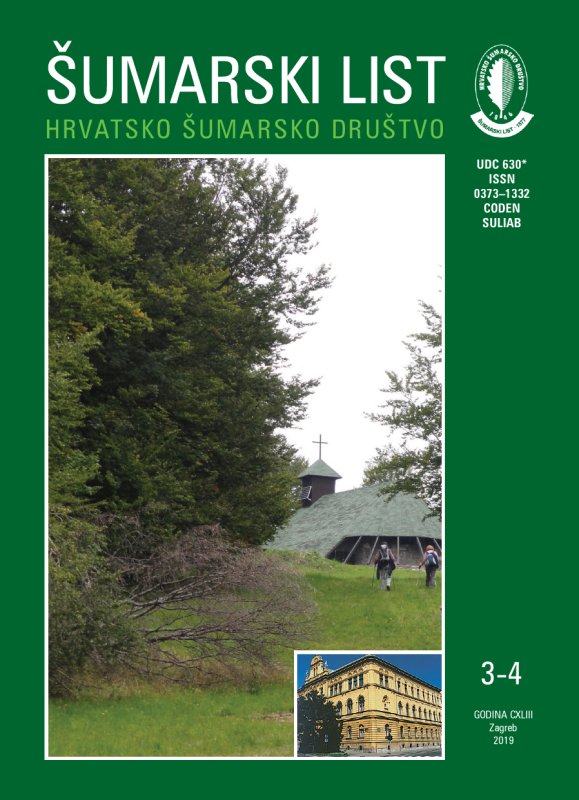
broj: 3-4/2019
pdf (8,59 MB) |
|
||||||||||||||
| RIJEČ UREDNIŠTVA | ||
| Uredništvo | ||
| Establishing yet another study of forestry in Croatia pdf HR EN | 101 | |
| IZVORNI ZNANSTVENI ČLANCI | ||
| Jelena Kranjec Orlović, Ivan Andrić, Ida Bulovec, Danko Diminić | UDK 630*443 (001) https://doi.org/10.31298/sl.143.3-4.1 | |
| Mycobiota in the seeds of narrow-leaved ash (Fraxinus angustifolia Vahl) pdf HR EN | 103 | |
| Ida Katičić Bogdan, Davorin Kajba, Saša Bogdan | UDK 630* 232.3 (001) https://doi.org/10.31298/sl.143.3-4.2 | |
| Variability of clones in acorn production and its effect on effective population sizes and genetic diversity of crops in clonal seed orchards of pedunculate oak (Quercus robur L.) in Croatia pdf HR EN | 111 | |
| Marilena Idžojtić, Igor Anić, Ivan Šimić, Maja Anastazija Kovačević, Igor Poljak | UDK 630* 174(001) https://doi.org/10.31298/sl.143.3-4.3 | |
| Dendrological characteristics of the Trsteno Arboretum pdf HR EN | 125 | |
| PRETHODNO PRIOPĆENJE | ||
| Mladen Zadravec, Toni Koren, Boris Lauš, Ivona Burić, Barbara Horvatić | UDK 630* 419 https://doi.org/10.31298/sl.143.3-4.4 | |
| Preliminary data on the beetle (Coleoptera) fauna of Turopoljski Lug forest pdf HR EN | 145 | |
| Kenan Zahirović, Tarik Treštić, Azra Čabaravdić, Mirza Dautbašić , Osman Mujezinović | UDK 630* 443 https://doi.org/10.31298/sl.143.3-4.5 | |
| Causitive agents of decay of norway spruce /Picea abies (L.) Karst./ on the mountain Zvijezda pdf HR EN | 155 | |
| Martin Bobinac, Siniša Andrašev, Andrijana Bauer-Živković, Nikola Šušić | UDK 630* 561 https://doi.org/10.31298/sl.143.3-4.6 | |
| Growth elements of the trees and the stand of Gymnocladus dioicus (L.) K. Koch at Fruška gora (Serbia) pdf HR EN | 161 | |
| PREGLEDNI ČLANCI | ||
| Zdenko Franić | UDK 630*892 https://doi.org/10.31298/sl.143.3-4.7 | |
| Apiforestry – beekeeping and forestry pdf HR EN | 171 | |
| Summary The paper presents a history of the interaction of beekeeping and forestry (apiforestry) in Croatia through an overview of scientific and professional literature and systematizes the most relevant recommendations and conclusions. Almost all authors recommend the planting of plants and trees rich in nectar and pollen as a precondition for advanced beekeeping and mitigating the adverse effects of climate change on bees. When planting and restoring forests, acacia, lime and chestnuts are especially recommended. The benefits of pollination service and biodiversity sustainment provided by bees, which at EU level is estimated at about € 1280 per bee colony, are much higher than the benefits of honey and other bee products. In Croatia, apiforestry, especially in chestnut forests, provides opportunities for the development of innovative activities and services based on beekeeping. One example is apitherapy as a health segment of beekeeping tourism. Apiforestry should continue to be a subject of multidisciplinary research and coordination, whereas cooperation between the sectors of forestry and beekeeping should be continuously improved. Key words: forestry; beekeeping; honey plants; pollination; biodiversity | ||


